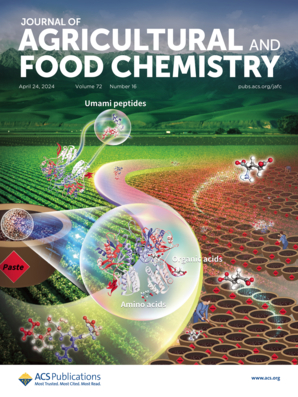Copper-Induced DRP1 Activation Disrupts Mitochondrial-Lipid Droplet Contact to Promote Hepatic Steatosis.
IF 6.2
1区 农林科学
Q1 AGRICULTURE, MULTIDISCIPLINARY
引用次数: 0
Abstract
Copper (Cu) is a vital dietary element for both humans and animals and is widely supplemented in food. However, excessive consumption of this trace element can adversely affect the overall well-being. Previous studies have demonstrated that long-term Cu intake can lead to severe hepatotoxicity. The underlying mechanism by which Cu induces disturbances in hepatic energy metabolism through modulation of mitochondria-lipid droplet (LD) contacts, however, is not known. In this study, we found that Cu exposure significantly disrupted the interaction between mitochondria and LDs, leading to the downregulation of perilipin 2 (PLIN2), perilipin 5 (PLIN5), synaptosomal-associated protein 23 (SNAP23), diacylglycerol acyltransferase 2 (DGAT2), and caveolin-1 (Cav-1) proteins in chicken livers. Mechanistically, we demonstrated that Cu exposure-induced dynamin-related protein 1 (DRP1) protein activation disrupted mitochondria-LD contacts by regulating PLIN2. DRP1 knockdown and PLIN2 overexpression efficiently promoted the mitochondria-LD contacts, alleviating Cu-induced LD accumulation in chicken primary hepatocytes. However, PLIN2 knockdown significantly exacerbated the mitochondria-LD contact disorder induced by Cu exposure. Moreover, PLIN2 knockdown dramatically reversed the ability of DRP1 knockdown to promote mitochondria-LD contacts, while overexpression of PLIN2 had the opposite effect. Overall, our study revealed that the DRP1-PLIN2 axis regulates the connections between mitochondria and LDs under Cu exposure, which may provide a new perspective on Cu exposure-induced lipid metabolism disorders in hepatocytes.铜诱导的DRP1激活破坏线粒体-脂滴接触,促进肝脏脂肪变性。
铜(Cu)是人类和动物的重要膳食元素,被广泛补充于食物中。然而,过量摄入这种微量元素会对整体健康产生不利影响。先前的研究表明,长期摄入铜可导致严重的肝毒性。然而,铜通过调节线粒体-脂滴(LD)接触诱导肝脏能量代谢紊乱的潜在机制尚不清楚。在本研究中,我们发现Cu暴露显著破坏了线粒体和ld之间的相互作用,导致鸡肝脏中近脂蛋白2 (PLIN2)、近脂蛋白5 (PLIN5)、突触体相关蛋白23 (SNAP23)、二酰基甘油酰基转移酶2 (DGAT2)和小窝蛋白1 (Cav-1)蛋白的下调。在机制上,我们证明了Cu暴露诱导的动力蛋白相关蛋白1 (DRP1)蛋白激活通过调节PLIN2破坏线粒体- ld接触。DRP1的下调和PLIN2的过表达有效地促进了线粒体与LD的接触,减轻了cu诱导的LD在鸡原代肝细胞中的积累。然而,PLIN2敲低显著加重了Cu暴露诱导的线粒体- ld接触障碍。此外,PLIN2敲低显著逆转了DRP1敲低促进线粒体- ld接触的能力,而PLIN2过表达则具有相反的效果。总之,我们的研究揭示了DRP1-PLIN2轴调控Cu暴露下线粒体和ld之间的联系,这可能为Cu暴露诱导的肝细胞脂质代谢紊乱提供新的视角。
本文章由计算机程序翻译,如有差异,请以英文原文为准。
求助全文
约1分钟内获得全文
求助全文
来源期刊
CiteScore
9.90
自引率
8.20%
发文量
1375
审稿时长
2.3 months
期刊介绍:
The Journal of Agricultural and Food Chemistry publishes high-quality, cutting edge original research representing complete studies and research advances dealing with the chemistry and biochemistry of agriculture and food. The Journal also encourages papers with chemistry and/or biochemistry as a major component combined with biological/sensory/nutritional/toxicological evaluation related to agriculture and/or food.

 求助内容:
求助内容: 应助结果提醒方式:
应助结果提醒方式:


